Garden Wildlife
Garden Wildlife


Centipedes
Centipedes belong to the class Chilopoda and have long segmented bodies with many legs. They can be confused with millipedes, which also have long segmented bodies and many pairs of legs. Centipedes have just one pair of legs per segment, whereas millipedes have two pairs. They have prominent antennae which are probably more useful when getting around in soil or leaf litter than eyes. Most have simple ocelli, some have small compound eyes, and many others are blind. Centipedes are active carnivores, subduing their prey using venom injected by the large jaw-like forcipules under the head, which are modified from the first pair of limbs.
Biology
Centipedes are predatory animals that feed on a wide range of small soil-dwelling invertebrates. The legs on the first segment behind the head curve forward and are modified to form a pair of fangs or forcipules. These seize the prey and inject venom to subdue it. During the day, surface dwelling centipedes, such as the Lithobius species, stay hidden in dark places. At night they come out to feed.
Centipedes might be expected to have 100 legs but no centipede species has that number. None of the British and Irish species has an even number of pairs of legs.
Life cycle
Lithobius species lay eggs singly in the surface layers of the soil. The species that live deeper in the soil lay batches of about 30 eggs and remain with them until after they have hatched. Young Lithobius (and Scutigera) resemble the adults but have fewer body segments and hence fewer legs. They add pairs of legs with each moult and gradually increase in size until they are fully mature, which may take two or three years. Geophilomorph centipedes are born with their full complement of legs, and don't add more with successive moults.
Role of centipedes in gardens
Centipedes prey on a wide range of small invertebrates and are a useful component of the garden ecosystem. Although some exotic centipedes are capable of inflicting a painful bite, the species found in the British Isles are entirely harmless.
Other sources of information
Website
http://www.bmig.org.uk Website of the British Myriapod and Isopod Group
Books
Barber, A. D. (2008) Key to the Identification of British centipedes. A Field Studies Council AIDGAP key
Barber, A. D. (2009) Synopses of the British Fauna, vol. 58, Centipedes. Linnean Society
Page drafted by Andrew Halstead, reviewed by Andrew Salisbury and compiled and extended by Steve Head
Left, head of house centipede Scutigera coleoptera showing antennae and small compound eyes. Right: ventral view of the head of Scolopendra cingulata showing the very strong forcipules.
Species in Britain and Ireland
There are about 50 species of centipede in Britain and Ireland, plus another seven introduced species that occur only in heated glasshouses. Jennifer Owen recorded 7 species in her garden, mostly from pitfall traps and including members of the three main British and Irish Orders.
Snake centipedes, Geophilomorpha
The geophilomorphs are blind centipedes that live within the soil and have long slender bodies that enable them to wriggle between the grains. Globally, it is the most diverse centipede Order, with 31 species in Britain and Ireland. They are generally pale yellow with darker heads and are 20-60mm long and about 2mm wide when fully grown. Centipedes in the Geophilomorpha have variable numbers of legs, depending on the species. Stigmatogaster subterranea, which can be up to 60mm long, has up to 83 pairs of legs when adult.
Common species found in gardens include Stigmatogaster subterranea, Schendyla nemorensis, Geophilus electricus, Geophilus flavus and Geophilus insculptus. Geophilus carpophagus They are sometimes referred to as snake centipedes because of the way in which they writhe when they are unearthed.
.jpg)
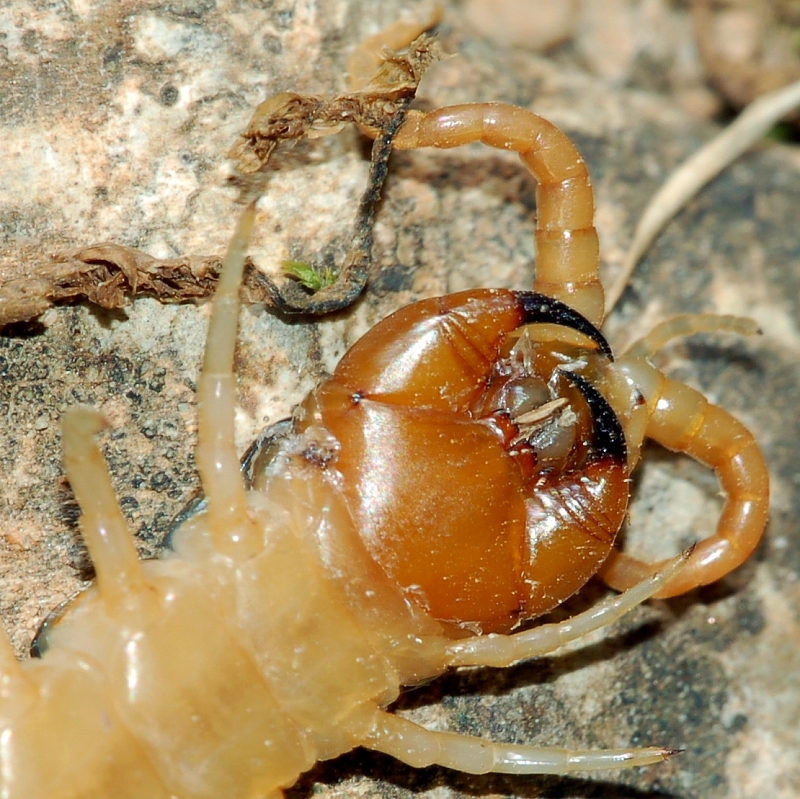
There is fourth Order present, especially in the channel islands. The house centipede Scutigera coleoptrata is our only representative of the Scutigeromorpha. It is relatively short-bodied, with up to 15 very long legs and antennae, well developed compound eyes, and can run very fast. Originally from the Mediterranean, it has spread around the world and is often found in homes. In Britain it is usually found in heated warehouses, but it can live outdoors in the Channel Islands, so just might be seen in gardens there.
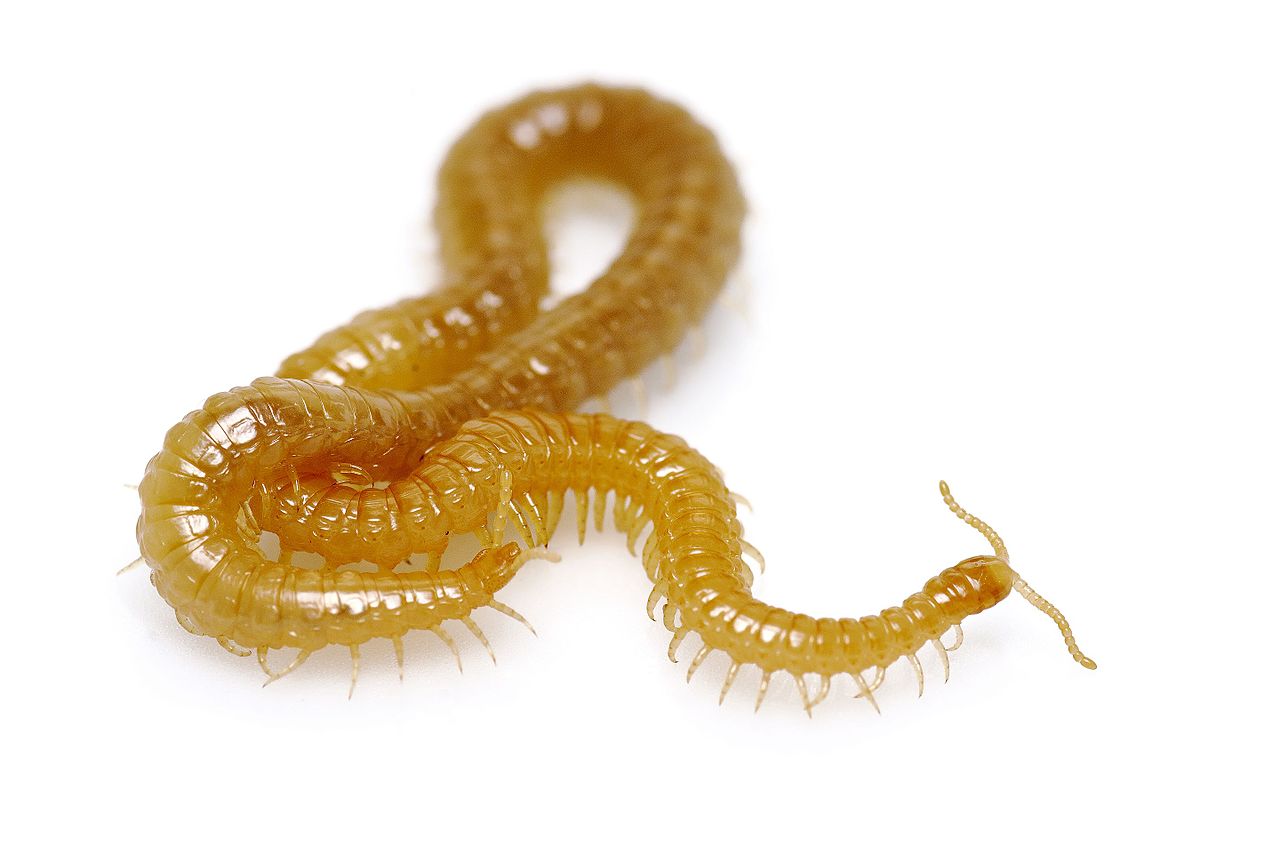
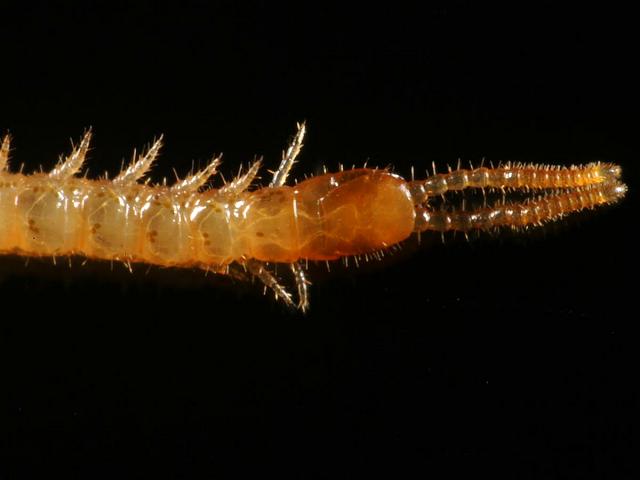
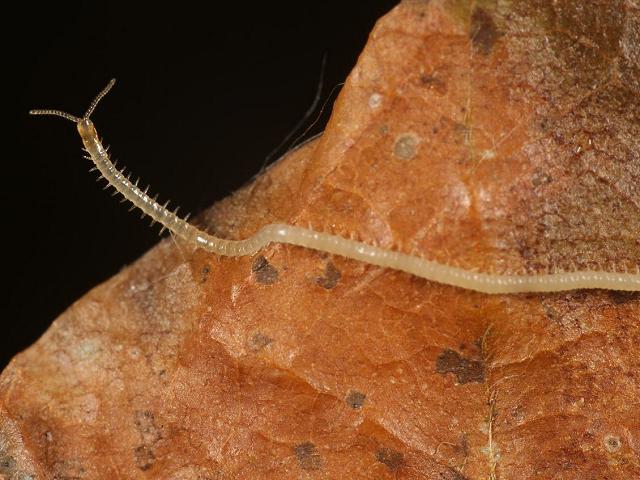
,_Arnhem,_the_Netherlands.jpg)
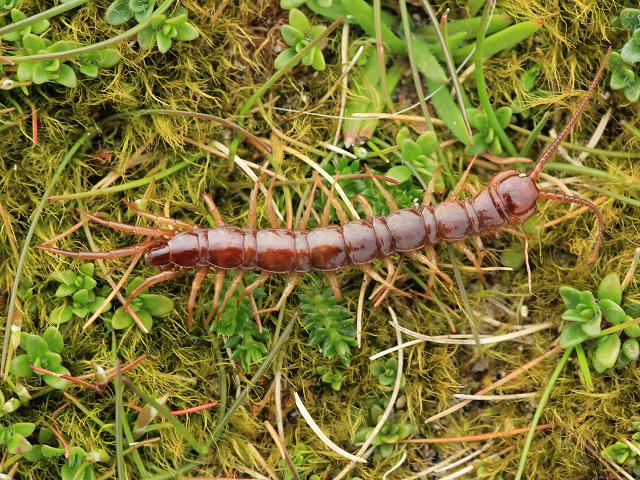
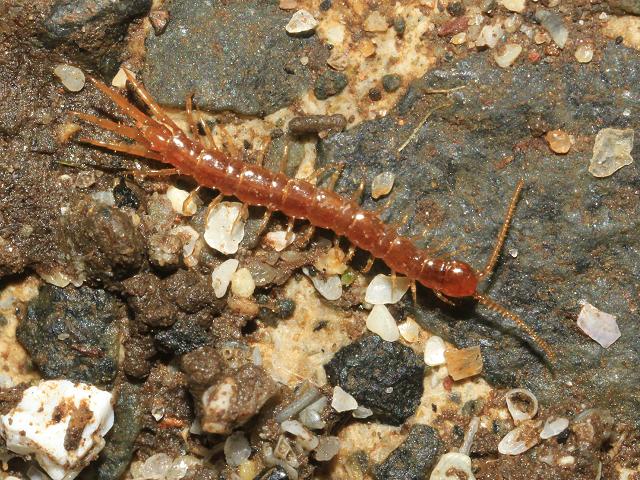
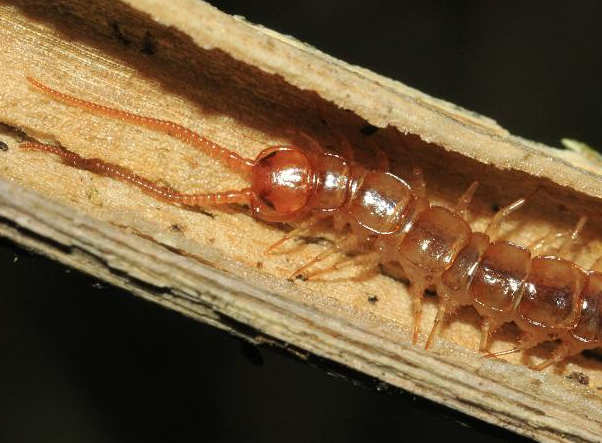
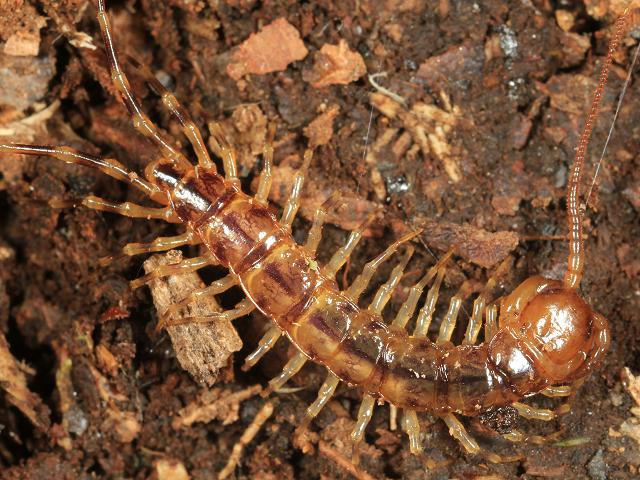
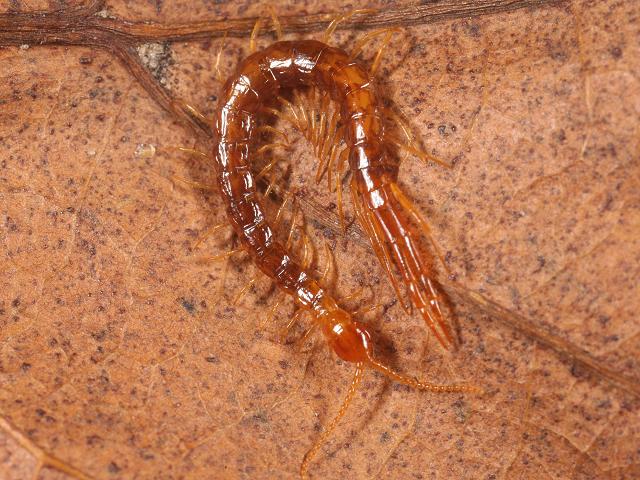
Scolopendromorph centipede Cryptops hortensis
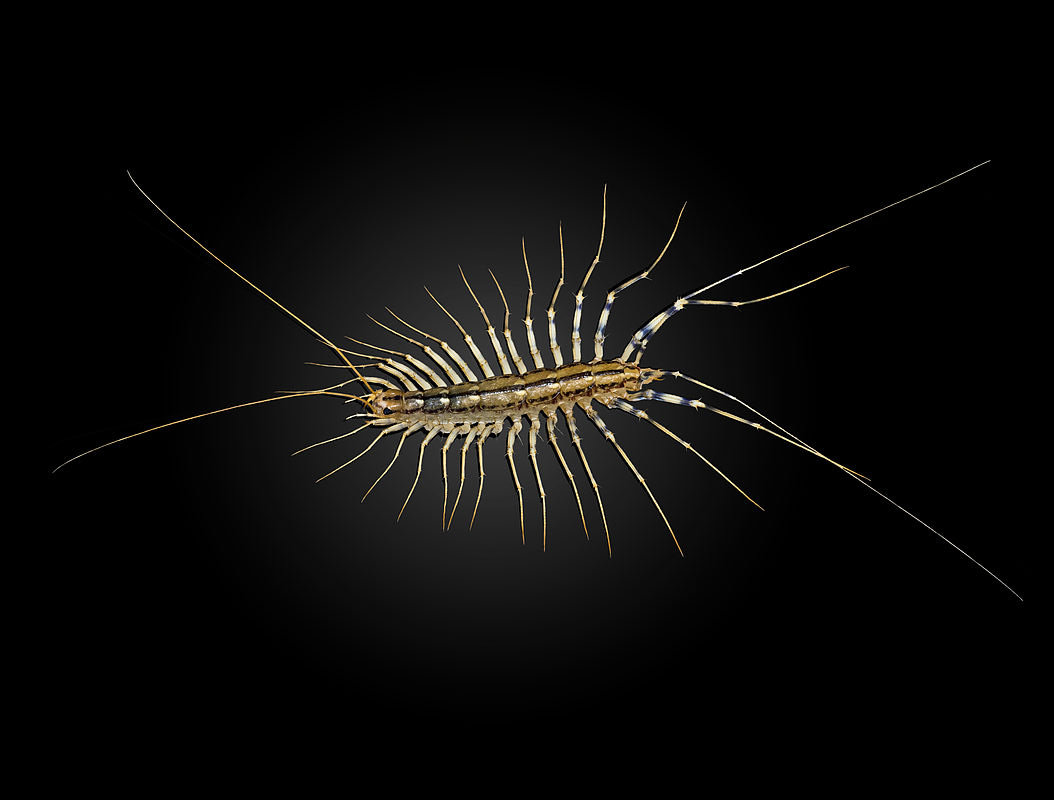
House centipede Scutigera coleoptrata
See also the photo of the head of this species at the top of the page, showing compound eyes.
Geophilomorph centipedes: Clockwise from top left: Stigmatogaster subterranea, Schendyla nemorensis, Geophilus flavus and Geophilus electricus
Stone centipedes Lithobiomorpha
There are 21 species of this order in Britain and Ireland. They are very different from the geophilomorphs, with a relatively short body and fifteen pairs of long legs (seven when young) which allow them to move quite fast. They live in leaf litter and the soil surface and can often be found sheltering under stones, logs and pots. They are orange brown in colour and are 9-30mm long and up to 4mm wide when fully grown. Common garden species are Lithobius crassipes, Lithobius forficatus, Lithobius melanops, Lithobius microps and the common banded centipede Lithobius variegatus.
Lithobiomorph centipedes: Clockwise from top left: Lithobius forficatus, Lithobius mrops, common banded centipede Lithobius variegatus and Lithobius melanops hiding in a nettle stem.
"Tropical centipedes" Scolopendromorpha
The scolopendromorph centipedes include only six species in Britain and Ireland, and only one, the common cryptops Cryptops hortensis is likely to be seen in gardens - and occasionally in houses. In habits it is like Lithobius species, but with 21 pairs of legs. It reaches 30mm in length, but there is a related non-native species, Cryptops anomalans found sporadically in the midlands, that reaches 50mm.

Lithobiomorph centipedes: Clockwise from top left: Lithobius forficatus, Lithobius mrops, common banded centipede Lithobius variegatus and Lithobius melanops hiding in a nettle stem.
"Tropical centipedes" Scolopendromorpha
The scolopendromorph centipedes include only six species in Britain and Ireland, and only one, the common cryptops Cryptops hortensis is likely to be seen in gardens - and occasionally in houses. In habits it is like Lithobius species, but with 21 pairs of legs. It reaches 30mm in length, but there is a related non-native species, Cryptops anomalans found sporadically in the midlands, that reaches 50mm.
Centipedes
Centipedes belong to the class Chilopoda and have long segmented bodies with many legs. They can be confused with millipedes, which also have long segmented bodies and many pairs of legs. Centipedes have just one pair of legs per segment, whereas millipedes have two pairs. They have prominent antennae which are probably more useful when getting around in soil or leaf litter than eyes. Most have simple ocelli, some have small compound eyes, and many others are blind. Centipedes are active carnivores, subduing their prey using venom injected by the large jaw-like forcipules under the head, which are modified from the first pair of limbs.
.jpg)

Left, head of house centipede Scutigera coleoptera showing antennae and small compound eyes. Right: ventral view of the head of Scolopendra cingulata showing the very strong forcipules.
Species in Britain and Ireland
There are about 50 species of centipede in Britain and Ireland, plus another seven introduced species that occur only in heated glasshouses. Jennifer Owen recorded 7 species in her garden, mostly from pitfall traps and including members of the three main British and Irish Orders.
Snake centipedes, Geophilomorpha
The geophilomorphs are blind centipedes that live within the soil and have long slender bodies that enable them to wriggle between the grains. Globally, it is the most diverse centipede Order, with 31 species in Britain and Ireland. They are generally pale yellow with darker heads and are 20-60mm long and about 2mm wide when fully grown. Centipedes in the Geophilomorpha have variable numbers of legs, depending on the species. Stigmatogaster subterranea, which can be up to 60mm long, has up to 83 pairs of legs when adult.
Common species found in gardens include Stigmatogaster subterranea, Schendyla nemorensis, Geophilus electricus, Geophilus flavus and Geophilus insculptus. Geophilus carpophagus They are sometimes referred to as snake centipedes because of the way in which they writhe when they are unearthed.



,_Arnhem,_the_Netherlands.jpg)
Geophilomorph centipedes: Clockwise from top left: Stigmatogaster subterranea, Schendyla nemorensis, Geophilus flavus and Geophilus electricus
Stone centipedes Lithobiomorpha
There are 21 species of this order in Britain and Ireland. They are very different from the geophilomorphs, with a relatively short body and fifteen pairs of long legs (seven when young) which allow them to move quite fast. They live in leaf litter and the soil surface and can often be found sheltering under stones, logs and pots. They are orange brown in colour and are 9-30mm long and up to 4mm wide when fully grown.Common garden species are Lithobius crassipes, Lithobius forficatus, Lithobius melanops, Lithobius microps and the common banded centipede Lithobius variegatus.





Scolopendromorph centipede Cryptops hortensis
There is fourth Order present, especially in the Channel Islands. The house centipede Scutigera coleoptrata is our only representative of the Scutigeromorpha. It is relatively short-bodied, with up to 15 very long legs and antennae, well developed compound eyes, and can run very fast. Originally from the Mediterranean, it has spread around the world and is often found in homes. In Britain it is usually found in heated warehouses, but it can live outdoors in the Channel Islands, so just might be seen in gardens there.

House centipede Scutigera coleoptrata
See also the photo of the head of this species at the top of the page, showing compound eyes.
Biology
Centipedes are predatory animals that feed on a wide range of small soil-dwelling invertebrates. The legs on the first segment behind the head curve forward and are modified to form a pair of fangs or forcipules. These seize the prey and inject venom to subdue it. During the day, surface dwelling centipedes, such as the Lithobius species, stay hidden in dark places. At night they come out to feed.
Centipedes might be expected to have 100 legs but no centipede species has that number. None of the British and Irish species has an even number of pairs of legs.
Life cycle
Lithobius species lay eggs singly in the surface layers of the soil. The species that live deeper in the soil lay batches of about 30 eggs and remain with them until after they have hatched. Young Lithobius (and Scutigera) resemble the adults but have fewer body segments and hence fewer legs. They add pairs of legs with each moult and gradually increase in size until they are fully mature, which may take two or three years. Geophilomorph centipedes are born with their full complement of legs, and don't add more with successive moults.
Role of centipedes in gardens
Centipedes prey on a wide range of small invertebrates and are a useful component of the garden ecosystem. Although some exotic centipedes are capable of inflicting a painful bite, the species found in the British Isles are entirely harmless.
Other sources of information
Website
http://www.bmig.org.uk Website of the British Myriapod and Isopod Group
Books
Barber, A. D. (2008) Key to the Identification of British centipedes. A Field Studies Council AIDGAP key
Barber, A. D. (2009) Synopses of the British Fauna, vol. 58, Centipedes. Linnean Society
Page drafted by Andrew Halstead, reviewed by Andrew Salisbury and compiled and extended by Steve Head









